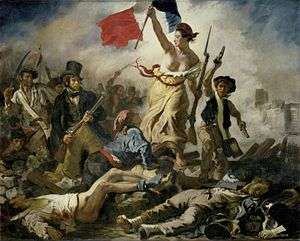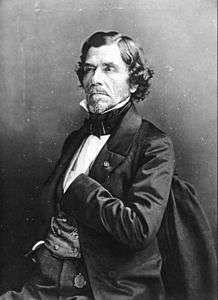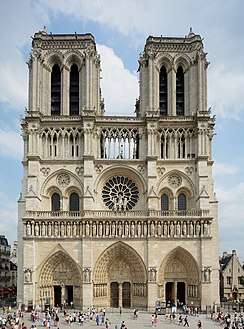Liberty Leading the People
Liberty Leading the People (French: La Liberté guidant le peuple [la libɛʁte ɡidɑ̃ lə pœpl]) is a painting by Eugène Delacroix commemorating the July Revolution of 1830, which toppled King Charles X of France. A woman of the people with a Phrygian cap personifying the concept of Liberty leads a varied group of people forward over a barricade and the bodies of the fallen, holding the flag of the French Revolution – the tricolour, which again became France's national flag after these events – in one hand and brandishing a bayonetted musket with the other. The figure of Liberty is also viewed as a symbol of France and the French Republic known as Marianne.
| Liberty Leading the People | |
|---|---|
| French: La Liberté guidant le peuple | |
 | |
| Artist | Eugène Delacroix |
| Year | 1830 |
| Medium | Oil on canvas |
| Dimensions | 260 cm × 325 cm (102.4 in × 128.0 in) |
| Location | Louvre, Paris[1] |
History
By the time Delacroix painted Liberty Leading the People, he was already the acknowledged leader of the Romantic school in French painting.[2] Delacroix, who was born as the Age of Enlightenment was giving way to the ideas and style of romanticism, rejected the emphasis on precise drawing that characterised the academic art of his time, and instead gave a new prominence to freely brushed colour.
Delacroix painted his work in the autumn of 1830. In a letter to his brother dated 21 October, he wrote: "My bad mood is vanishing thanks to hard work. I've embarked on a modern subject—a barricade. And if I haven't fought for my country at least I'll paint for her." The painting was first exhibited at the official Salon of 1831.
Symbolism
Delacroix depicted Liberty as both an allegorical goddess-figure and a robust woman of the people. The mound of corpses and wreckage acts as a kind of pedestal from which Liberty strides, barefoot and bare-breasted, out of the canvas and into the space of the viewer. The Phrygian cap she wears had come to symbolize liberty during the first French Revolution, of 1789. The painting has been seen as a marker to the end of the Age of Enlightenment, as many scholars see the end of the French Revolution as the start of the romantic era.[3]
The fighters are from a mixture of social classes, ranging from the bourgeoisie represented by the young man in a top hat, a student from the prestigious École Polytechnique wearing the traditional bicorne, to the revolutionary urban worker, as exemplified by the boy holding pistols. What they have in common is the fierceness and determination in their eyes. Aside from the flag held by Liberty, a second, minute tricolore can be discerned in the distance flying from the towers of Notre Dame.[4]
The identity of the man in the top hat has been widely debated. The suggestion that it was a self-portrait by Delacroix has been discounted by modern art historians.[5] In the late 19th century, it was suggested the model was the theatre director Étienne Arago; others have suggested the future curator of the Louvre, Frédéric Villot;[6] but there is no firm consensus on this point.
Several of the figures are probably borrowed from a print by popular artist Nicolas Charlet, a prolific illustrator who Delacroix believed captured, more than anyone else, the peculiar energy of the Parisians.[7]
Purchase and exhibition
The French government bought the painting in 1831 for 3,000 francs with the intention of displaying it in the throne room of the Palais du Luxembourg as a reminder to the "citizen-king" Louis-Philippe of the July Revolution, through which he had come to power. This plan did not come to fruition and the canvas hung in the palace's museum gallery for a few months, before being removed due to its inflammatory political message. After the June Rebellion of 1832, it was returned to the artist. According to Albert Boime,
Champfleury wrote in August 1848 that it had been "hidden in an attic for being too revolutionary." Although Louis-Philippe's Ministry of the Interior initially acquired it as a gesture to the Left, after the uprising at the funeral of Lamarque in June 1832 it was never again openly displayed for fear of setting a bad example.[8]
Delacroix was permitted to send the painting to his aunt Félicité for safekeeping. It was exhibited briefly in 1848, after the Republic was restored in the revolution of that year, and then in the Salon of 1855. In 1874, the painting entered the collection of Palais du Louvre in Paris.
In 1974–75, the work was the featured work in an exhibit organized by the French government, the Metropolitan Museum of Art in New York and the Detroit Institute of Arts as a Bicentennial gift to the people of the United States. The exhibit, entitled French Painting 1774–1830: The Age of Revolution, marked a rare display of the Delacroix painting, and many of the other 148 works, outside France.[9] The exhibit was first shown at the Grand Palais from 16 November 1974 to 3 February 1975. It moved to Detroit from 5 March to 4 May 1975, then New York from 12 June to 7 September 1975.[10]
In 1999, it was flown on board an Airbus Beluga from Paris to Tokyo via Bahrain and Calcutta in about 20 hours. The large canvas, measuring 2.99 metres (9.8 feet) high by 3.62 metres (11.9 feet) long, was too large to fit into a Boeing 747. It was transported in the vertical position inside a special pressurised container provided with isothermal protection and an anti-vibration device.[11]
In 2012, it was moved to the new Louvre-Lens museum in Lens, Pas-de-Calais, as the starring work in the first tranche of paintings from the Louvre's collection to be installed.[12] On 7 February 2013, the painting was vandalized by a visitor in Lens. An unidentified 28-year-old woman allegedly wrote an inscription ("AE911") on the painting.[13][14] The woman was immediately arrested by a security guard and a visitor. A short time after the incident, the management of the Louvre and its Pas-de-Calais branch published a press release indicating that "at first glance, the inscription is superficial and should be easily removed".[15][16] Louvre officials announced the next day that the writing had been removed in less than two hours by a restorer without damaging the original paint, and the piece returned to display that morning.[14]
Legacy


Although Delacroix was not the first artist to depict Liberty in Phrygian cap, his painting may be the best known early version of the figure commonly known as Marianne, a symbol of the French Republic and of France in general.[17]
The painting may have influenced Victor Hugo's novel Les Misérables. In particular, the character of Gavroche is widely believed to have been inspired by the figure of the pistols-wielding boy running over the barricade.[18][19][20][21] The novel describes the events of the June Rebellion two years after the revolution celebrated in the painting, the same rebellion that led to its being removed from public view.
The painting inspired Frédéric Auguste Bartholdi's Liberty Enlightening the World, known as the Statue of Liberty in New York City, which was given to the United States as a gift from the French a half-century after Liberty Leading the People was painted.[7] The statue, which holds a torch in its hand, takes a more stable, immovable stance than that of the woman in the painting. An engraved version of part of the painting, along with a depiction of Delacroix, was featured on the 100 franc note from 1978 to 1995.
The painting has had an influence on classical music. George Antheil titled his Symphony No. 6 After Delacroix, and stated that the work was inspired by Liberty Leading the People.[22] The imagery was adapted by Robert Ballagh to commemorate Ireland's independence struggle on an Irish postage stamp in 1979, the centenary of the birth of Pádraig Pearse,[23] and the painting was used for the band Coldplay's album cover Viva la Vida or Death and All His Friends, with the words Viva La Vida written in white.[24] The cover of the book Enough is Enough: How to Build a New Republic by Fintan O'Toole references the painting, but with Kathleen Ni Houlihan holding the Irish tricolour in Dublin while the leaders of the three main political parties at the time (Brian Cowen, Enda Kenny and Eamon Gilmore) lie on the ground.[25]
During the 20 October 2011 episode of the BBC Radio 4 series In Our Time, host Melvyn Bragg led a panel discussion of painting.[26]
Criticism
Liberty Leading the People is considered to be a republican and anti-monarchist symbol, and thus was sometimes criticized, especially by royalists and monarchists.[27][28][29]
See also
- Liberté, égalité, fraternité
- Liberty (goddess)
- Marianne
Notes and references
- Dorbani, Malika Bouabdellah. "July 28: Liberty Leading the People". Musée du Louvre. Retrieved 14 May 2015.
- Noon et al. 2003, p. 58.
- Renwick, William Lindsay (1889). The Rise of the Romantics 1789–1815: Wordsworth, Coleridge, and Jane Austen. Oxford: Clarendon Press, 1990, c1963 ISBN 978-0-1981-2237-1
- Boime, Albert (2004). Art in an Age of Counterrevolution, 1815–1848. Chicago: University of Chicago Press. p. 237. ISBN 978-0-2260-6337-9.
- Toussaint, Hélene (1982). La Liberté guidant le peuple de Delacroix. Paris: Editions de la Réunion des Musées Nationaux.
- Pool 1969, p.33.
- Part 3, Liberty Leading the People. The Private Life of a Masterpiece. BBC. 2005. Archived from the original on 6 January 2011.
- Boime, Albert (1 February 2008). Art in an Age of Civil Struggle, 1848–1871. Chicago: University of Chicago Press. p. 16. ISBN 978-0-2260-6342-3.
- Marsha Miro (2 March 1975). "At the Institute of Arts, A Heroic Show from France". Detroit Free Press. p. D1.
- Detroit Institute of Arts, Metropolitan Museum of Art (1975). French painting 1774–1830, the Age of Revolution. Detroit: Wayne State University Press.
- "Airbus A300-600ST Super Transporter". All About Guppys. Retrieved 26 February 2013.
- Chrisafis, Angelique (4 December 2012). "Louvre opens 'glass river' on Lens slagheap". The Guardian. London. Retrieved 4 December 2012.
- Battersby, Mathilda (8 February 2013). "Delacroix Liberty painting defaced by woman with marker pen at Louvre exhibition". The Independent. London. Retrieved 8 February 2013.
- Lichfield, John (8 February 2013). "The mystery of AE911 Cryptic code scrawled on Delacroix's vandalised masterpiece". The Independent.
- "La liberté guidant le peuple de Delacroix dégradée au Louvre-Lens". Le Nouvel Observateur (in French). Agence France-Presse. 7 February 2013. Retrieved 7 February 2013.
- Magdeleine, Emmanuel (7 February 2013). "Louvre-Lens: "La liberté guidant le peuple" de Delacroix a été tagué à l'encre indélébile". France 3 Nord Pas-de-Calais (in French). Retrieved 7 February 2013.
- Warner, Marina (2000). Monuments & Maidens: The Allegory of the Female Form. University of California Press. pp. 270–71. ISBN 978-0520227330.
- Mould, Michael (2011). The Routledge Dictionary of Cultural References in Modern French. Taylor & Francis. p. 112. ISBN 978-1-1368-2573-6.
- Berg, William (2007). Imagery and Ideology: Fiction and Painting in Nineteenth-Century France. Associated University Presse. p. 106. ISBN 978-0-8741-3995-2.
- Néret, Gilles (2000). Eugène Delacroix, 1798–1863: The Prince of Romanticism. Taschen. p. 26. ISBN 978-3-8228-5988-9.
- Pool, Phoebe (1969). Delacroix. London: Hamlyn, p.33
- Tuttle, Raymond. "George Antheil, Symphonies #1 & 6. Frankfurt Radio Symphony Orchestra/Hugh Wolff". Classical.Net. Retrieved 12 June 2012.(review)
- Heindorff, Ann Mette (24 July 2006). "Eugène Delacroix (1798–1863)". Art History on Stamps. Archived from the original on 19 July 2017. Retrieved 26 February 2013.
- Petridis, Alexis (5 June 2008). "Coldplay, Viva la Vida or Death and All His Friends". The Guardian.
- O'Toole, Fintan (28 October 2010). Enough is Enough: How to Build a New Republic. Faber & Faber. ISBN 978-0-5712-7010-1.
- "Delacroix's Liberty Leading the People". In Our Time. 20 October 2011. BBC Radio 4. Retrieved 3 July 2018.
- MobileReference (2010). Paris Sights: A Travel Guide to the Top 45 Attractions in Paris, France. MobileReference. p. 276. ISBN 978-1-60778-976-5.
- Petrey, Sandy (2005). In The Court Of The Pear King: French Culture And The Rise Of Realism. Cornell University Press. p. 101. ISBN 978-0-8014-4341-1.
- O'Loughlin, John (27 January 2013). Insane But Not Mad. Centretruths Digital Media. ISBN 978-1-4476-6376-8.
Bibliography
- Cook, Bernard A. (2006). Women and war: a historical encyclopedia from antiquity to the present. Santa Barbara, Calif. [u.a.]: ABC-Clio. ISBN 978-1-8510-9770-8.
- Noon, Patrick (10 June 2003). Crossing the Channel: British and French Painting in the Age of Romanticism. Harry N. Abrams. ISBN 978-1-8543-7513-1.
- Pastore, Stephen R. (2012) Zola and Delacroix: Genius Amidst the Turmoil. London: Oxford University Press
- Pool, Phoebe (1969). Delacroix. London: Hamlyn. ISBN 978-0-6000-3796-5.
- Prideaux, Tom (1972). The World of Delacroix. Time-Life Books. p. 79. ISBN 978-0-8094-0262-5.
External links
| External video | |
|---|---|

- Louvre
- Podcast of BBC Radio 4's In Our Time on Delacroix's Liberty Leading the People
- Eugène Delacroix (1798–1863): Paintings, Drawings, and Prints from North American Collections. Full text exhibition catalog from The Metropolitan Museum of Art, which discusses the painting.
- Romanticism in France Delacroix's Liberty Leading the People From smarthistory.
- ArtSleuth: Liberty Leading the People, accidental icon ? Video analysis.

